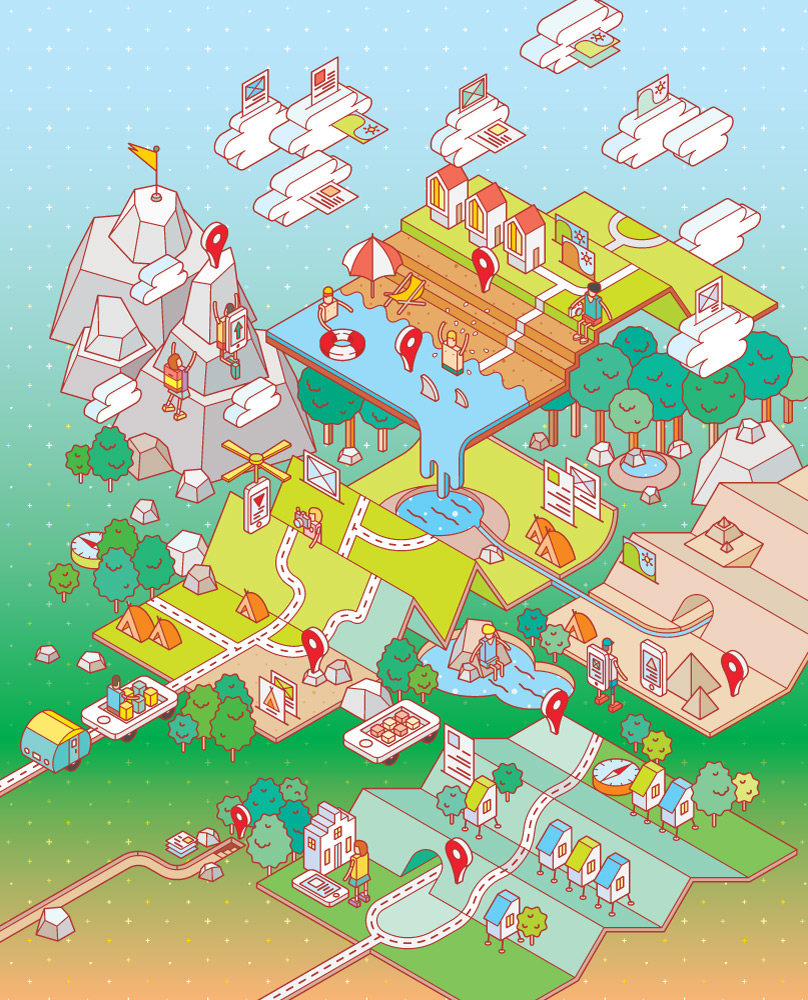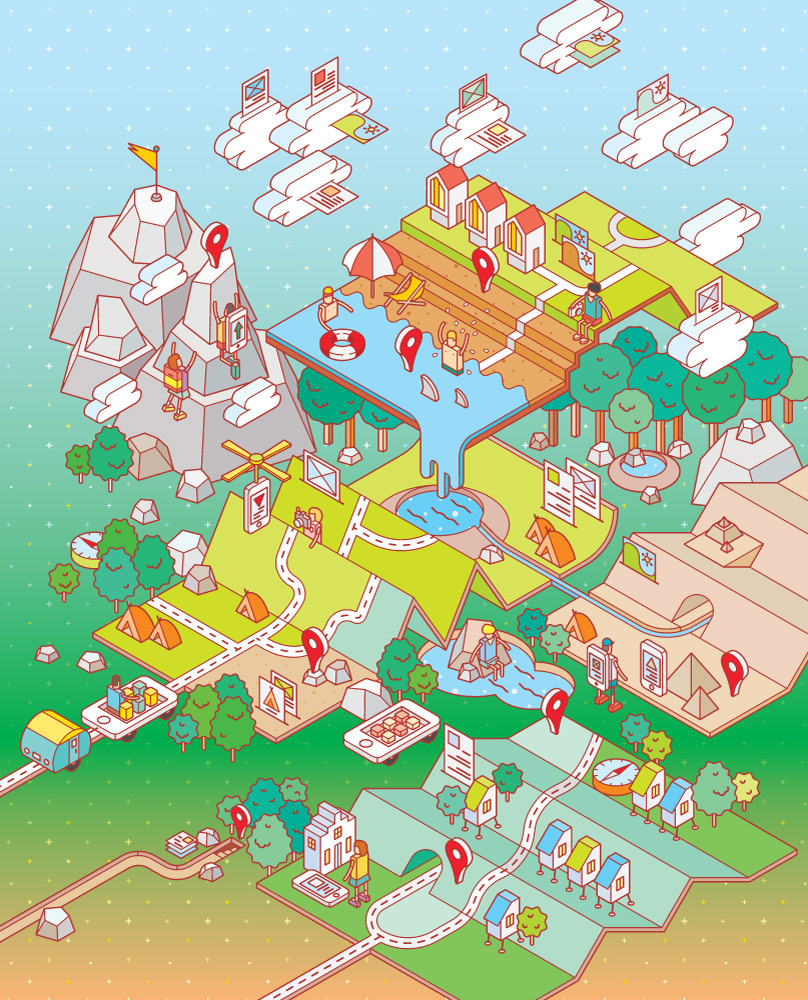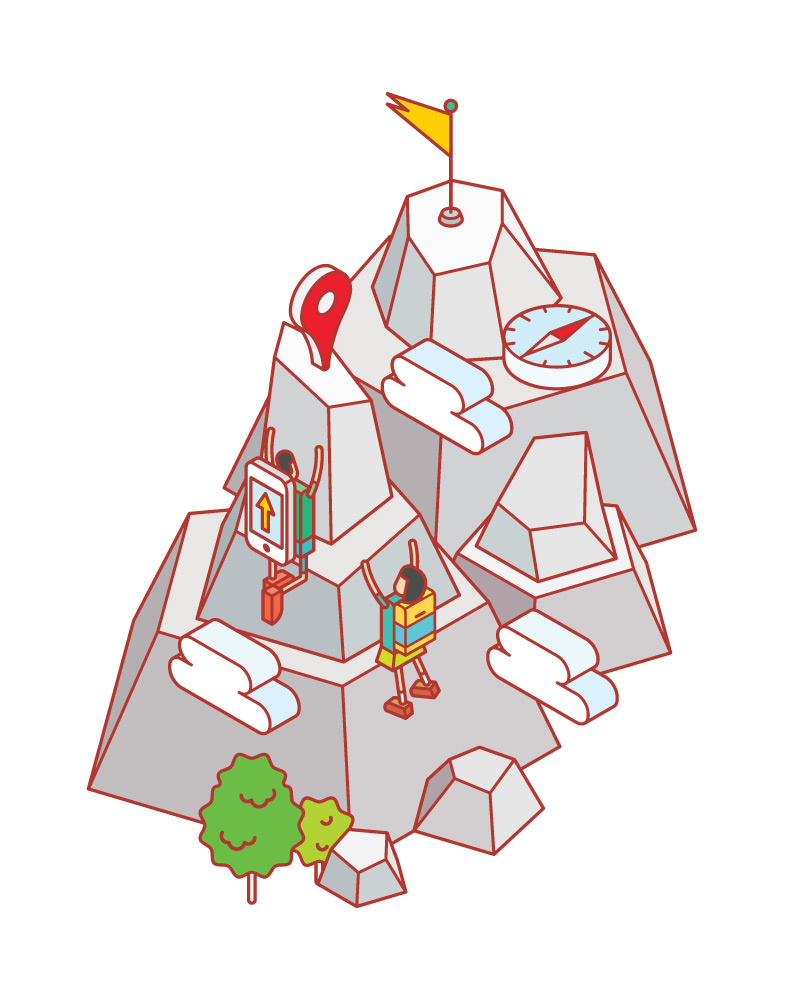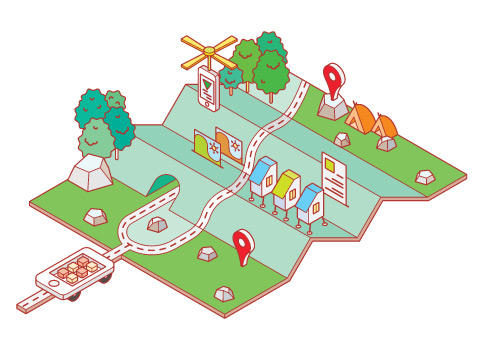Appy Travels
Personal technology, often blamed for keeping us distanced from reality, is in fact helping the modern traveller to be immerse themselves deep within their destination.

There was a time when a well-thumbed copy of a Rough Guide was the key to a city’s secrets – the cafés to linger in, the promenades to walk along, the country pubs where one could be assured of a warm welcome. But today’s explorers are busy thumbing through their mobile phones instead, as a wealth of smartphone apps and websites guides tech-savvy, authenticity- seeking travellers into the heart of a city or country, using crowdsourcing and social media to offer reviews of hotspots from likeminded tourists, make introductions to local residents, and even provide real-time updates about the most popular places to be in. Unfasten your seatbelts – we’ve touched down in the era of the ‘silent’ tourist, who shows up in a new place and quietly melts into the crowd, smartphone in hand, ready to live life like the locals do.
Travellers’ motivation to unearth an authentic experience isn’t new, of course. From the bustling Kyoto izakaya full of grilled squid and late-night local revellers to the Sicilian butcher frequented only by Italian grandmammas, such unmarked, undocumented gems of the local experience often make for the best travel anecdotes.
“Travellers want to immerse themselves into a culture,”says Tom Marchant, co-founder of luxury tour operator Black Tomato. “And if you want to see the soul of a place, or get a sense of what makes a city tick, it’s about finding local experiences – where to hang out and what time to be there.”
As people increasingly depend on their smartphones for everyday needs, whether to order groceries, hail a taxi or keep track of their health, it follows that – once equipped with a good data-roaming plan or with the Wi-Fi Finder app activated – they also look to their gadgets when wanderlust strikes.
More than four in five (87%) global travellers use their smartphone while on holiday, according to 2013 research by TripAdvisor, and more than one in two (61%) use social media while on vacation. Meanwhile, nearly half (44%) of all travellers use their smartphone to research travel while they’re travelling, according to a NinthDecimal report last year.
If you want to see the soul of a place, or get a sense of what makes a city tick, it’s about finding local experiences

“Travellers are naturally very tied to their devices when on the road – checking email, reading news from home, posting to social networks,” confirms Kevin May, editor and co-founder of travel and technology news website Tnooz. “They are far more independent, adventurous, sophisticated and empowered than ever before, not least because they have instant access to information via the web.”
There are myriad ways for an app or website to connect with travellers throughout what May calls the “travel cycle” – from pre-travel research to the actual trip and the post-trip period. For ‘silent’ travellers keen on the fully authentic, down-and-dirty experience, the best digital resources harness social media and crowdsourced reviews so users learn from everyday folk such as likeminded travellers and local habitants, rather than from a lofty expert with a singular point of view. As Marchant says, “travellers want knowledge from people on the ground” – and these people are the best way for our ‘silent’ tourists to hit that ground running.
Pick and Mix
Some travellers may pick a holiday destination by spinning a globe and stopping it with one fortuitously placed index finger. Others head online for seemingly endless pages of inspiration,
whether it’s of crystal-clear waters or teeming street markets. Looking to tailor travellers’ experiences, increasing numbers of websites are sharing unusual places or current hotspots on micro-social networks.
A collection of curious and unexpected places all over the world, Atlas Obscura serves up intriguing doses of inspiration for travellers who think they’ve seen it all. People can search the globe for rare-book libraries, wonder cabinets, or unusual museums dedicated to nearly anything, including salt, absinthe, vibrators or the Spanish occult. Once they have visited a place, users can leave a review to help out other travellers or, if the destination isn’t already listed, send a tip to the website’s editors to include it. User discussions of different destinations also spill over to Atlas Obscura’s actively updated Facebook page, where people may connect with one another to discern the most authentic experience of a particular place.

Another catalogue of dream-worthy destinations, Triptease includes ideas and recommendations of cities to visit, road trips to embark on, hotels to stay in and afternoon teas to try all around the globe. Taking the anonymity out of many online critiques, the website puts a face to each reviewer, adding a note describing each person’s interests so that like-minded travellers can share tips.
Lay Your Head
Once a traveller has chosen a location to visit, online peer-topeer services help find a local’s home, rather than an impersonal chain hotel, to stay in, for that all-authentic experience. Beyond
hugely popular home-rental service Airbnb, new homesharing websites offer local
accommodation for everyone from backpackers to billionaires. Where Airbnb may seem overwhelming – it has more than 800,000 listings worldwide accessed by millions of people –smaller networks take on a gatekeeper function, appealing to specific groups of people based on their common interests. Taking to heart the principle of ‘like attracts like’, these guarded networks aim to give travellers an increased sense of trust, security and, yes, authenticity.
Targeted to alumni from top universities worldwide including INSEAD, Columbia University and the London School of Economics, FlatClub creates a trusted network of users by enabling hosts to limit their rentals to alumni of specific institutions. Anyone can register with the website, but only
those people with a university email address can access the alumni-only rentals.

With addresses available in more than 150 countries, Home Exchange lists apartments, cabins, chateaux, camper vans and even a 40-foot yacht that members may consider home sweet
vacation home. Any person with an abode of some sort to put up for exchange is welcome to use the service.
Appealing to the well-heeled, monogram-luggaged crowd, 3rd Home, available to members who pay a $2,500 initiation fee, offers a catalogue of luxury vacation homes including a Patagonian ranch house and a six-bedroom villa in a bustling neighbourhood in Bali.
Encouraging users to share campsites rather than one another’s home, Hipcamp enables happy campers to discover and book the best campsites in California. The listing for each site, whether
on a beach, in the mountains or tucked away within a forest, includes information about nearby activities and tips for a successful camping trip, nuggets of wisdom include: “Raccoons are extremely crafty here – they have turned the art of stealing food into a science!”
Native Navigation
Smartphone apps are incredibly handy when it comes to planning a travel itinerary – no more flipping through guide books looking for a folded page corner or a particular highlighted paragraph. Making them even more relevant for ‘silent’ travellers who want to slip straight into their new environment while on the move, curated apps help break through the mass of travel information online to offer the most suitable content for each traveller.
New curated city-guide apps avoid the obvious tourist spots and offer ideas that even local residents can get excited about. In opposition to other all-in-one event calendars that can often
seem overwhelming, Los Angeles-based 5 Every Day brings just five things to do or places to explore in the city each day, from last-minute concerts to secret gardens or a favourite picnic spot. Created by multimedia pop band Yacht, the app appeals to young creatives keen on tapping into the communal, authentically Angeleno brains of “local artists, musicians, designers and
folks-about-town”.
We want to provide the best recommendations – a tailored list of events that also puts into context your geographical location
Other intuitive apps sift through social media information and user-generated content online to produce up-to-date suggestions that match a user’s interests.
“We want to provide the best recommendations – a tailored list of events that also puts into context your geographical location,” says Luis-Daniel Alegría, co-founder and CEO of Vamos, an event guide app that sifts through public Facebook, Eventbrite and Ticketmaster events happening in a user’s area to offer the most relevant activity suggestions. “Plus, the more we know about you, the better we can recommend. Our score mechanic takes into account the events that you’ve been to, and suggests others that you might be interested in going to.” People who log in to Vamos with their Facebook account can also check in advance if any of their friends or contacts are attending a particular event – “turning friends into event curators”, as Vamos puts it.

Meanwhile, taking a highly visual approach to itinerary planning, Jetpac (which was bought by Google in August) trawls through publicly available Instagram photos and analyses common traits
to compile cheeky top 10 lists of local recommendations in thousands of cities from Kingston in Jamaica to Kathmandu: a bevy of blue skies suggests the best options for panoramic views,
while a mass of moustaches hints at the best hipster cafés. A ‘snappyness’ rating – based on the number of Instagram photos tagged to any particular place – means users always receive updated information on trending addresses.
Elsewhere, algorithm-based apps and websites aim to provide a personalised experience for each user. Deli Amsterdam starts its users off with a quick quiz to determine their preferences and interests, then suggests the most suitable hotspots for each tourist – an eclectic, arty café for a casual creative perhaps, or a jazz club for a sophisticated, whisky-drinking type. Similarly, Tripsuit (which was still in its beta testing phase as Protein Journal went to print) styles itself as a digital travel agent: users answer some questions about their interests and travelling style and the app then crunches this data along with activity ratings shared by other travellers to tailor an ideal trip.
On the Fly
Having a well-thought-out itinerary of local finds is one thing; knowing a city’s happening hotspots at any particular time is quite another. A freshly arrived tourist might have heard about
a new restaurant or a little-known viewing spot, but only an experienced local with on-the-ground contacts would know about a low-key, one-time-only concert by a so-hot-right now band. From This is Now’s real-time, constantly updated Instagram snapshots of life in cities around the world, to Taxi Trails’ GPS-enabled guide to Stockholm’s most popular cab journey destinations, new smartphone apps analyse real-time social media data on popular places so people can work out how best to be part of the local scene.
We want to help highlight serendipitous experiences for people who are out and about, and who are looking for inspiration for things to do nearby

“Travellers often plan the top 10 things they want to do in a new city,” Alegría says. “But we want to help highlight serendipitous experiences for people who are out and about, and who are looking for inspiration for things to do nearby. You could be about to have dinner, then suddenly find an impromptu barbecue with a bunch of local musicians.” By adding a value score to each listed event, Vamos is able to rank each open-invite fashion line launch, public book-club meeting or rooftop yoga session according to its time, location and popularity.
Meanwhile, Localmind enables its users to find out what’s happening at a particular place at any given moment, by asking someone who’s already there. Localmind members who check in at a bar, club or restaurant using a check-in service such as Foursquare become available to field a question about that location – how long the queue is outside a new no-reservations restaurant, perhaps, or if there are any free drinks available at a comic book convention.
Gleaning information from nearly 200 publishers including TimeOut, Zagat and the Food Network, Field Trip works in tandem with Google Now to offer flash-card recommendations of places to explore while its users are on the move. Covering everything from gigs and local bars to notable architecture and public art, the GPS-enabled app offers nuggets of information about famous and hidden locations as people approach or pass by them.
Going Native
Strangers in a strange land, our ‘silent’ travellers, while keeping mum, still want to connect with local residents in their quest for an authentic experience. “Foreign travel is about engaging with other people and other cultures – that’s what people find romantic about it,” says Marchant, a strong proponent of “just talking to a local and finding out about the city”. But for those travellers who are struck by shyness or an inability to speak the local language,smartphone apps that encourage individuals to leave notes for the people around them may be the next best thing.
Virgin America teamed up with networking apps LinkedIn and Here on Biz to create its own social network, where Virgin flyers can connect with one another. Travellers on Virgin flight scan see and digitally reach out to people on their flight, those on other Virgin America flights in the air, or fellow travellers at their destination.
Findery lets users annotate any geographical location – an address, a street corner, a signpost at the end of a road – and leave notes for others to pick up. See a local lad playing guitar at a market but don’t dare approach him? A tech-savvy ‘silent’ traveller could leave him a virtual note and hope fate – in the guise of Findery – steps in.
Designed by artists Jon Nash and Michael Petruzzo, Slight is an app that enables people to anonymously ‘speak’ to everyone in the room – everyone, that is, who has downloaded the app.People can use Slight to talk to others around them (within a 40-metre radius), or simply geo-tag thoughts and notes to certain places for future visitors to read. Users don’t have to signup or build a profile – the notes are completely anonymous, so ‘silent’ travellers remain just that.


